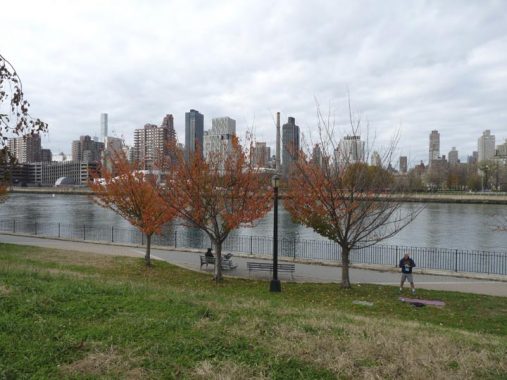
ODDLY enough, both The Bronx and Queens have Rainey Parks, named for two separate Raineys. The Bronx Rainey Park, pictured here, is by far the newer one as it was constructed in 1986 atop the old roadbed of Kelly Street between Longwood and Intervale Avenues, which by the 1980s, along much of the south Bronx, had become a wasteland of abandoned tenements (most of which have been torn down and newer housing constructed, thankfully). This stretch of Longwood was in dire need of a park, as the closest one prior to the 1980s was Crotona Park, several blocks away.
The park was built with the encouragement of William F. Rainey (1920-1985), an African-American veteran of World War II and a dedicated leader who helmed the Police Athletic League Lynch Community Center for over twenty years as well as served as Vice Chairman of Community Board 2. The city acquired the Kelly Street properties through condemnation in 1984, demolished most of them and constructed the park over the next few years. Sadly, Rainey did not live long enough to see the park given his name in 1991; previously, it was the prosaically-named Kelly Street Park.

Queens’ Rainey Park is an expansive riverside park is named for a local resident, Dr. Thomas Rainey (1824-1910) who worked tirelessly for the construction of the Queensboro Bridge.
Rainey had been one of the earliest and staunchest supporters of the project, and the burden of organizing and refinancing the company fell on him, first as treasurer in 1874, then as president in 1877. Dr. Rainey lobbied around the country to get financial backing and a bridge franchise. However, the War Department, concerned that a bridge could interfere with the defense of New York and access to the Brooklyn Navy Yard, withheld approval. Most interest in the region was for another bridge between Brooklyn and Manhattan. The sparse population in Queens at the time raised further concerns of need and profitability, and the project had once again lost steam by 1892. NYC Parks
A group from the community called the Committee of Forty kept the effort alive. After the consolidation of New York City in 1898, the project gained new momentum and the bridge was finally built at Queens Plaza, a few blocks south of the proposed location. Rainey crossed the new Queensboro on opening day in 1909 with Governor Charles Evans Hughes.
The city acquired land here, at what was originally going to be the Queens bridge landing, in 1904 and designated it for a public park, which opened in 1912.
As always, “comment…as you see fit.” I earn a small payment when you click on any ad on the site.
1/20/23


7 comments
I remember Rainey Park Queens very well. Spent many a day (and night) there, along with hopping the fence to the next door marble company shoreline. And the right field that had a slight hill to it. Good times there
Understand that, at the time Dr. Rainey was looking to build his bridge, that part of Queens County was the City of Long Island City, which had just broken away from Town of Newtown. LIC was governed by a crooked mayor named Henry Debevoise who probably was looking to get his piece of the action if the thing were ever built. I have no idea whether he was the Debevoise of the “[…] & Plimpton” law firm, but I would imagine that if not, he was somehow related.
The crooked mayor I remember reading about was “Battleaxe” Gleason, although in its short life LIC could have had more than one crook running things
Debevoise preceded Gleason by a decade or so. I’m pretty sure secession from Town of Newtown was so that the Debevoises and Gleasons could have their own little fiefdom for mischief.
IT’S NICE TO SEE MANY PARTS OF THE CITY.
I had the opportunity to attend a Kelly Stree reunion at this park. It was great to meet some of the people I grew up with.
The hard part was having the mental picture of the neighborhood I grew up in from Dawson to Kelly Street. Longwood to interval laying beneath an expanse of grass. It felt like visiting a cemetery where my youth was buried.
If Rainey Park was going to the Queens bridge landing, then looking at John Jay Park, was that going to be the landing on the Manhattan side?